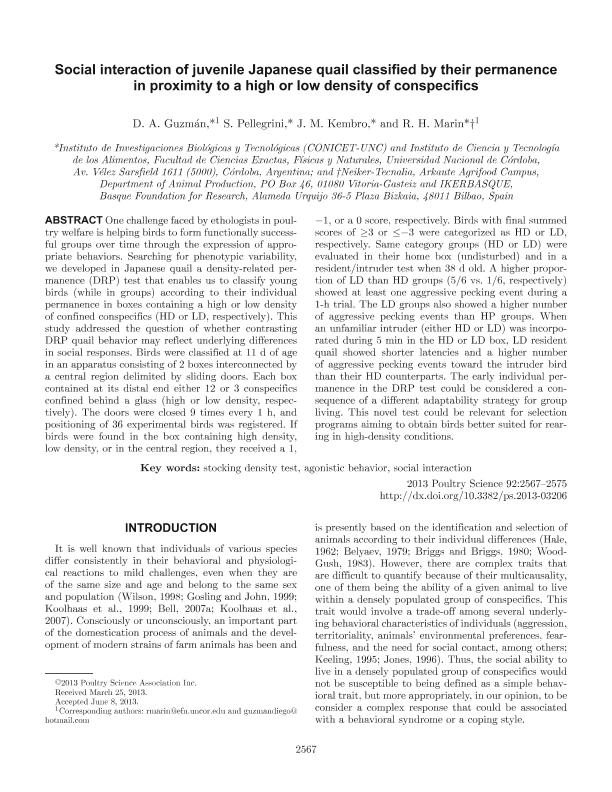Mostrar el registro sencillo del ítem
dc.contributor.author
Guzmán, Diego Alberto

dc.contributor.author
Pellegrini, Stefanía

dc.contributor.author
Kembro, Jackelyn Melissa

dc.contributor.author
Marin, Raul Hector

dc.date.available
2019-08-28T13:33:19Z
dc.date.issued
2013-10
dc.identifier.citation
Guzmán, Diego Alberto; Pellegrini, Stefanía; Kembro, Jackelyn Melissa; Marin, Raul Hector; Social interaction of juvenile Japanese quail classified by their permanence in proximity to a high or low density of conspecifics; Poultry Science Association; Poultry Science; 92; 10; 10-2013; 2567-2575
dc.identifier.issn
0032-5791
dc.identifier.uri
http://hdl.handle.net/11336/82336
dc.description.abstract
One challenge faced by ethologists in poultry welfare is helping birds to form functionally successful groups over time through the expression of appropriate behaviors. Searching for phenotypic variability, we developed in Japanese quail a density-related permanence (DRP) test that enables us to classify young birds (while in groups) according to their individual permanence in boxes containing a high or low density of confined conspecifics (HD or LD, respectively). This study addressed the question of whether contrasting DRP quail behavior may reflect underlying differences in social responses. Birds were classified at 11 d of age in an apparatus consisting of 2 boxes interconnected by a central region delimited by sliding doors. Each box contained at its distal end either 12 or 3 conspecifics confined behind a glass (high or low density, respectively). The doors were closed 9 times every 1 h, and positioning of 36 experimental birds was registered. If birds were found in the box containing high density, low density, or in the central region, they received a 1, -1, or a 0 score, respectively. Birds with final summed scores of ≥3 or ≤-3 were categorized as HD or LD, respectively. Same category groups (HD or LD) were evaluated in their home box (undisturbed) and in a resident/intruder test when 38 d old. A higher proportion of LD than HD groups (5/6 vs. 1/6, respectively) showed at least one aggressive pecking event during a 1-h trial. The LD groups also showed a higher number of aggressive pecking events than HP groups. When an unfamiliar intruder (either HD or LD) was incorporated during 5 min in the HD or LD box, LD resident quail showed shorter latencies and a higher number of aggressive pecking events toward the intruder bird than their HD counterparts. The early individual permanence in the DRP test could be considered a consequence of a different adaptability strategy for group living. This novel test could be relevant for selection programs aiming to obtain birds better suited for rearing in high-density conditions.
dc.format
application/pdf
dc.language.iso
eng
dc.publisher
Poultry Science Association

dc.rights
info:eu-repo/semantics/openAccess
dc.rights.uri
https://creativecommons.org/licenses/by-nc-nd/2.5/ar/
dc.subject
Agonistic Behavior
dc.subject
Social Interaction
dc.subject
Stocking Density Test
dc.subject.classification
Otras Ciencias Veterinarias

dc.subject.classification
Ciencias Veterinarias

dc.subject.classification
CIENCIAS AGRÍCOLAS

dc.subject.classification
Zoología, Ornitología, Entomología, Etología

dc.subject.classification
Ciencias Biológicas

dc.subject.classification
CIENCIAS NATURALES Y EXACTAS

dc.subject.classification
Producción Animal y Lechería

dc.subject.classification
Producción Animal y Lechería

dc.subject.classification
CIENCIAS AGRÍCOLAS

dc.title
Social interaction of juvenile Japanese quail classified by their permanence in proximity to a high or low density of conspecifics
dc.type
info:eu-repo/semantics/article
dc.type
info:ar-repo/semantics/artículo
dc.type
info:eu-repo/semantics/publishedVersion
dc.date.updated
2019-08-09T15:02:48Z
dc.identifier.eissn
1525-3171
dc.journal.volume
92
dc.journal.number
10
dc.journal.pagination
2567-2575
dc.journal.pais
Estados Unidos

dc.description.fil
Fil: Guzmán, Diego Alberto. Consejo Nacional de Investigaciones Científicas y Técnicas. Centro Científico Tecnológico Conicet - Córdoba. Instituto de Investigaciones Biológicas y Tecnológicas. Universidad Nacional de Córdoba. Facultad de Ciencias Exactas, Físicas y Naturales. Instituto de Investigaciones Biológicas y Tecnológicas; Argentina
dc.description.fil
Fil: Pellegrini, Stefanía. Consejo Nacional de Investigaciones Científicas y Técnicas. Centro Científico Tecnológico Conicet - Córdoba. Instituto de Investigaciones Biológicas y Tecnológicas. Universidad Nacional de Córdoba. Facultad de Ciencias Exactas, Físicas y Naturales. Instituto de Investigaciones Biológicas y Tecnológicas; Argentina
dc.description.fil
Fil: Kembro, Jackelyn Melissa. Consejo Nacional de Investigaciones Científicas y Técnicas. Centro Científico Tecnológico Conicet - Córdoba. Instituto de Investigaciones Biológicas y Tecnológicas. Universidad Nacional de Córdoba. Facultad de Ciencias Exactas, Físicas y Naturales. Instituto de Investigaciones Biológicas y Tecnológicas; Argentina
dc.description.fil
Fil: Marin, Raul Hector. Consejo Nacional de Investigaciones Científicas y Técnicas. Centro Científico Tecnológico Conicet - Córdoba. Instituto de Investigaciones Biológicas y Tecnológicas. Universidad Nacional de Córdoba. Facultad de Ciencias Exactas, Físicas y Naturales. Instituto de Investigaciones Biológicas y Tecnológicas; Argentina
dc.journal.title
Poultry Science

dc.relation.alternativeid
info:eu-repo/semantics/altIdentifier/doi/http://dx.doi.org/10.3382/ps.2013-03206
dc.relation.alternativeid
info:eu-repo/semantics/altIdentifier/url/https://academic.oup.com/ps/article/92/10/2567/1549224
Archivos asociados
